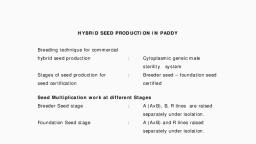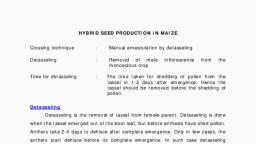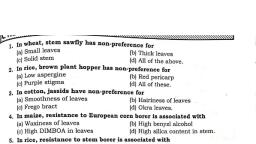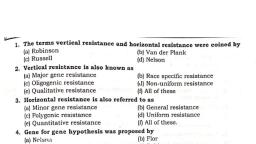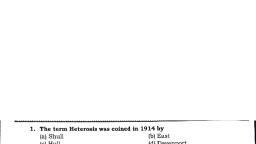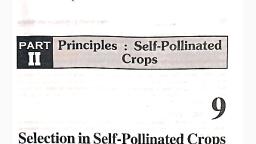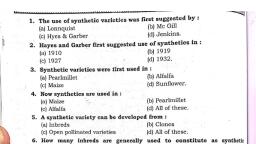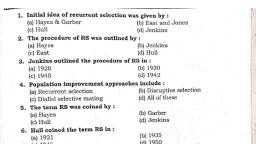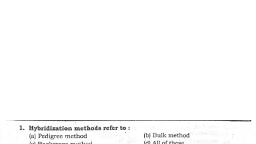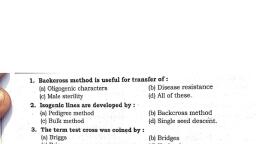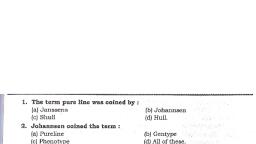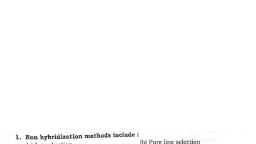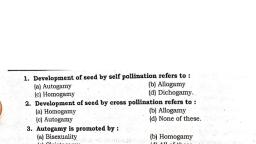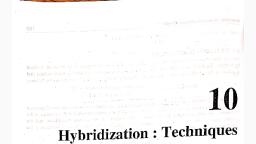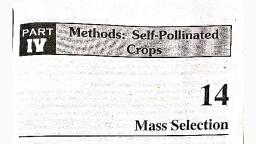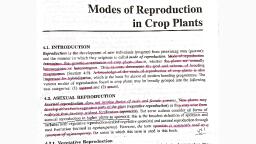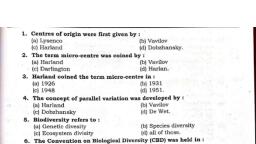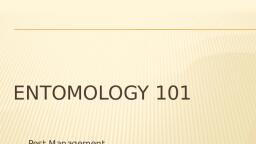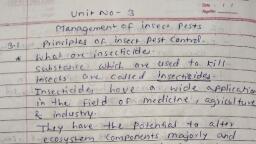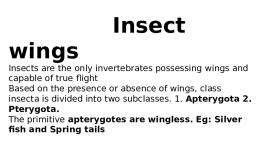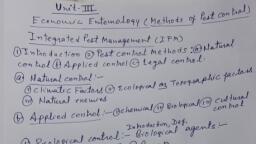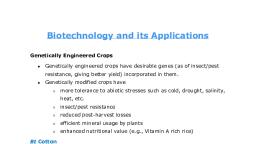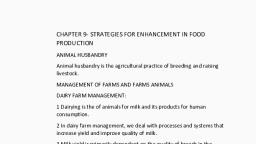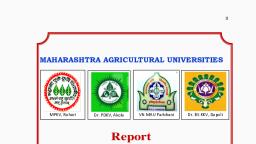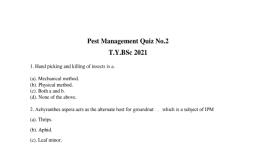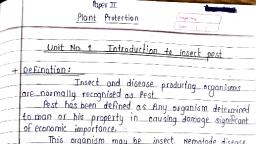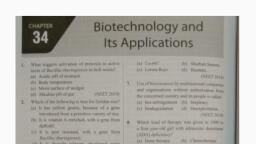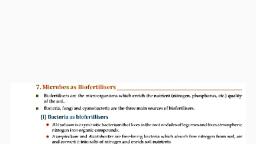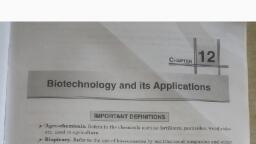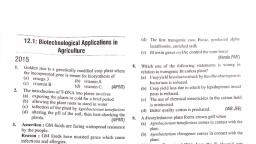Page 1 :
IL Insect Resistance, , 28.1. INTRODUCTION. - A, All crops:are attacked by insects, but the. degree of damage to as well as the number of insec, species attacking different crops vary considerably. For example, cotton is attacked by more th:, 160 species of insects; of these about a'dozen are major insect pests. Therefore, an effective pes, control measure is the basic requirement for a good cotton crop; as a result, about 60% of all the ”, Pesiticides used in the world is applied to cotton. On the other hand, crops like wheat and barley —, “are attacked by a few insect pests and none of these causes a serious damage. It may be noted =, that many insect pests. have a rather narrow host Tange, Le., they attack only a limited number, of plant species. But many other insects feed on several crop species, e.g., red cotton bug,, Helicoverpa, etc.; such insects are called polyphagous. Furthermore, an insect may move on, a new host species if its normal host crop is not available. aa, , Once it was hoped that chemical control measures will effectively control, or even eliminate, insect pests. But the experience has shown that extensive pesticide application (1) increases the, cost of crop production, (2) reduces the population of natural enemies (predators and parasites) ~, of insects pests, (3) leads to the development of pesticide-resistant biotypes of insects, and (4) _, pollutes the environment (the most tragic and horrifying example is the Bhopal Gas Tragedy of, December, 1984). Most entomologists now speak of ‘pest managemeni’ in the place of ‘pest., control’. Pest management involves, in addition to Pesticide application, several divergent measures 7, to minimise the losses due to insect pests. Insect resistant crop varieties, where available, form, an important component of pest management. Insect resistance is that Property of a variety of J, a host crop due to which it is attacked by an insect pest to a significantly lower degree than are —, , aoe 4, , r, , Scanned with CamScannér
Page 2 :
preedind for Resistance to Biotic Stresses : 11. Insect Resistance. x, “her varieties of we oe crop. Fri om a practical view point, an insect resistant variety produces :, rately larger yields v 8000 quality than do susceptible varieties with the same level of initial, ijestation (insect attack) under comparable environmental conditions. Thus, insect resistance is, peative property and can be defined only in comparison to other mor€ susceptible varieties., , Maxwell etal. vid) ave delined insect resistance as those heritable characteristics possessed, jyite plant, which influence the ultimate degree of damage done y insects”., pon, , 339. HISTORICAL, , . The first report of insect resistance dates back to 1792,, ‘Underhill’ was resistant to hessian fly (Mayetiola de., apple variety ‘Winter Majetin’ was resistant to wool, 1861, grape phylloxera (Daktulophaira vitifoliae) was controlled in France by the use of resistant, root stocks introduced from U.S.A.; this seems to be the first planned utilisation of insect resistance., The first review on insect resistance in plants was that by Snelling published in 1941. The most, significant development in breeding for insect resistance relates to the publication of the’ book., ‘Insect Resistance in‘Crop Plants’ by R.H. Painter in 1951. This book not only synthesized the, contemporary ‘knowledge ‘on the subject to develop them clearly into: the various concepts of, insect resistance; ‘but also provided the basic framework for further research. Subsequent, developments ‘have yielded a wealth of information on the various aspects of insect resistance and, its commercial exploitation. Asa result, breeding of insect resistant varieties is now an important, objective in many national and international crop improvement programmes. In addition, cultivation, , of insect resistant varieties is now considered a key component in the modern ‘pest management, practices... , 3 : ; : : :, , vA, , when Havens reported that wheat variety, structor). In 1831, Lindley reported that, ly apple aphid (Eriosoma langigerum). In, , 283. LOSSES DUE TO INSECTS é i :, , Insect-pests may be divided into two groups on the basis of their mode of feedings CY sucking ', , pests (they suck the. cell sap, e.g., aphids, jassids, thrips, white fly, mites, etc.), and (2) tissue, , Seeders (these feed on various plant parts, e.g., stem or shoot borers, root borers, fruit borers, leaf, , hoppers, weevils, beetles, étc.). Both the groups of insects reduce. the quality ‘as well as the, , quantity of crop yields. The loss’in quality of produce is more frequent and often of a greater, , Concern than that of quantity per se. Insect infestation leads to one . pon Seed iofewing, , direct damages: (4y reduced plant growth or stunting, (2) ame i re , a ranch, ae, , buds, flowers, vegetative buds, fruits and seeds, (377 premature defoliation, and even (Ay wilting, , of plants. The degree of damage depends primarily on the intensity of insect attack and the, Susceptibility of the host strain. In addition, insects alsocause indirect damage. Many insects,, , ‘ g,, aphids mites, white fly, etc., transmit.plant viruses, i.e., serve as vectors Of pathogens., , Further, injuries ‘caused by insects make ‘the plants more vulnerable to attacks by fungal and, , a, , bacterial pathogens." ene . vega itv., . The estimated global average loss due to insect pests in the potential yields of all the crops, is ~14q% (Cramer, 1967). The estimated losses in individual crops vary from 5% in wheat to over :, i 6% in Tice, and ‘still more in crops like cotton and sugarcane. a spite of : = o Gesemen tse 7, > 1 4, "Secticides and other control measures, the global average loss in a - © major crops ‘, exceeds 5 ; due to insect pests range from 10 to 20%. Losses due to insect pests i, s 5%. In India, losses due - Serate regions since high temperature and \“—, ore much i ical and subtropical than in temperate regions St :, hontai more in tropica duction. In cases of severe insects attack, yield losses, ; f, , ity promote insect activity and repro., , , , Scanned with CamScanner
Page 3 :
n, , 28.5. GENETICS OF VIRULENCE : ., An insect biotype capable of adaptation to the resistance mechanisms of a host strain so that it, , is able to infest and survive on the resistant host strain is called virulent. For example, wheat, , variety Monon carries the Gene Hy for hessian fly resistance. Hessian fly race Great Plains (GP), is Tinene to Monon, but race E is virulent. Genetics of virulence was investigated in the cross., , GP x E of hessian fly; Virulence was found to be governed by a single gene, and avirulence ied, dominant to virulence. It may be pointed out that during spermatogenesis in hessian fly males,, the paternal haploid genome (n=8) is eliminated and only the maternal genome forms viable, sperms. Therefore, the ratios in F2, and backcross generations depend on direction of the cross., Different biotypes of hessian fly may carry different genes for virulence; for example, biotypes, Band C have virulence genes M and K, respectively. In some cases, ¢.g., rice brown planthopper, , (N. lugens), virulence may be polygenically controlled., , 28.6. DEGREE OF RESISTANCE engage ash, , Resistance is a relative attribute and is measurable only in relation - suisigep al itey: une degr ee, , Of insect resistance may be grouped into the following five categories: (1) immunity, (2) high, _ ®sistance, (3) low resistance, (4) susceptibility, and (5) inigit auscepubility’ after, Painter C1951)., , munity descri “insect relationship in which the insect will not consume the plant, , tal escribes a host-insec er but a few cas f h, , Sader any condition. Therefore, an immune plant alos none “e —_—, , Scanned with CamScanner
Page 4 :
508 \S Plant Breeding: Principles and Meth, , ich level of resistance, the host plant possesses; suc}, , immunity have been reported. In case of a 4 t, ific insect under a given environment:, , traits that result in a small level of damage by a spec: ; nents), the level of resistance is such that the host suffers less than.average damage by an insect, The average. damage is assesséd on, , * —,, 771. averase, damage is assessed, katate Lo ere a ea att rage. dan, is Of: damage caused to a number of vari ties -of the, crop.in question. When the level, damage. or infestation-is-average_or more than average, it'is‘known a 1, case of high susceptibility, the level of infestation or, damage js much greater than the., , _forthe.crop. i 5208, , fee MECHANISM OF INSECT RESISTANCE — :, , An insect pest selects its host plant on the basis of odour and/or taste constituted by both pri, , _and secondary metabolites, including nutrients, present in the plants. Resistant varieties do,, , rovide the,.‘correct’ odour/taste and, thereby, interface with the host selection: process., WS chaniant ‘of reqistance Thay involve (ncreased levels of existing “allonrone’, (Section 28, , Y i —<— 5A) —-laveloorp a = ¢, new. allomones(\lowered kairomone YSegton” 26:9 Of physical factors. Allomones, Kairomones are plant bio eats, , , , , , , als traving adverse and favourable effects, respectively, on,, inséct pests. Insect resistance is grouped ito the following four categories: (1) nonpreference,, (®) antibiosis (3) tolerance, and (4) ecological. The first three types of resistance were recognized, by-Painter (1951), while the fourth. was included. subsequently. A given case of insect resist e, ‘may-exhibit one, more often, two or more of these mechanisms. For example, resistan, Brussel’s sprouts to cabbage: aphid involves nonpreference, antibiosis and tolerance. S, combinations of resistance, mechanisms are highly effective and are not easily overcome by, , concerned insect, pest. atest A ‘ #3, , 28.7.1. Nonpreference, Host varieties exhibiting this type of resistance are unattractive or unsuitable for colonization,, oviposition or both by an insect pest. This type of resistance is also termed as nonacceptance, and enosi (Xenos=guest). The term-nonacceptance appears to be more appropriate sin, in most known examples of this type of resistance the insects will not accept a resistant ‘host, variety even if there is no alternative source of food. But there are other cases, where nonp refere, , __ of a host strain is detectable only when the preferred host strain is present. There is consi, variation in the degree of nonpreference by insect pests. In some cases, the expression., , _, Sttong that the insects walk-off the resistant plants, e.g., aphid resistance in raspberry: In,, other’ cases, on the other hand, the insects do not walk-off the resistant plants, but they feed:, Te, , , , a comparatively shorter period and are generally restless on.the resistant plants as compared, susceptible ones, ¢.g., aphid resistance in sugarbeet (Russel, 1978). Nonpreference it, various morphological and biochemical features of host plants; which prevent insects fo:, approaching, landing, settling, feeding or ovipositing. Nonpreference may affect different activities, of the insect, ¢.g., colonisation, egg laying, feeding, etc. For example, cucumber ge Oty, showed two types of nonpreference to western flower thrips (Frankiliniella nocldenielt, , first type of nonpreference resulted in reduced ‘e i :, : s eg laying by fe 5, pA edie feeding by their larvae. rear e ey Sone thrips, while the secor, , , , , , complete rejection of the host. Cucurbits produce cucurbitacins (responsible for the bitter, which act as attractants and feeding inducers for insects like spotted cucumber beetle (Dial, , , , , , Scanned with CamScanner
Page 5 :
greoding for Resistance to Biotic Stresses : Il. Insect Resistance a, , sudecimpunctata howardi). Cucurbit ‘varieties that produce Jower: or zero levels: of specific, cuoubitacins attract fewer beetles and suffer less damage than others, This type of nonprevence, igiikely to breakdown particularly if alternate hosts are not found in the vicinity. Therefore, it, ig not greatly valued by plant breeders. Non-preference may also be caused by physical factors, of the host like pubescence, tissue characteristics and gummy exudates. For example, corn, eaworn, (Helicoverpa zea) prefers pubescent ‘surfaces for ovisposition; therefore, varieties that, lack hairs suffer much less damage due to reduced oviposition. This type of nonpreference is not, easily overcome by the insect pest, and may be used as the first line of defence in case of many, insect pests. Nonpreferred cultivars have not been grown on a large scale, and their durability,, is therefore, unknown. Many insect resistant Cultivars have some amount of hidden nonpreference,, which.may contribute: to the durability. of their resistance based on antibiosis. For example,, resistance of Lycopersicon hirsutum glabratym to: greenhouse white fly (Trialenrodes, yaporariorum) nicely combines both nonpreference and antibiotic resistances. But in the case of., a polyphagous insect like Heliothis zed, nonpreference may not be an effective mechanism of, , resistance since the insect will multiply on alternative hosts and may then cause’a much greater, damage to the crop. ’ ., , 28.7.2. Antibiosis —, , Antibiosis refers to.an adverse effect of feeding on a resistant host plant on the development, and/or reproduction of the insect pest. In severe cases, it may even lead to death of the imsect, pest. Antibiosis may involve morphological, physiological or biochemical features o, , plait or, in some cases, a combination of these features (Table 28.2). In many cases, allelochemics, (nonnutritional plant chemicals affecting insect behaviour; Section 28.9.3) are involved in antibiosis,, e.g., DIMBOA in maize, gossypol and related comounds in cotton and saponins in alfalfa (Table, 28.2). In addition, the type and the availability of primary metabolites may also be the basis of, antibiosis as it may cause nutritional imbalance in the insect pest. For-example, pea varieties, having low levels of amino acids and increased levels of sugar show resistance to pea aphid, (Acyrthosiphon pisum). Similarly, rice varieties having low levels of asparagine cause reduced, reproduction of brown planthopper. Antibiosis affects the physiology. of insects, and it may wa, influence different aspects of the life cycle, e.g., change in development period, fecundity. or, Teproduction rate, etc.; these aspects are called life history factors. A thorough understanding of, the Tife history factors and their relative contribution to the population growth of the target insect, is critical for the development of efficient and effective tests for resistance based on antibiosis., , 28.7.3. Tolerance . ofl, , Insect tolerance is similar to disease tolerance (Chapter 27). An insect tolerant variety ES attacked, by the insect pest to the same degree as a susceptible variety, Dut of the same level Of infestatio TQ infe tation,, “tolerant variety produces a larger yield than a susceptible variety. To Wor i ulate ee several, factors ike general vigour, compensatory growth in individual plants ‘a or een "sane wold, healing, mechanical support in tissues/organs, and photosynthate parti ceptible avietioeee, “tolerant varieties show greater recovery from pest da nee ie, example, tolerant varieties of maize repair and replace the roots camade acked bythe 2 ee, Worm (Diabrotica virgifera), so that they have greater root ork ss desne ey the’ est a, In other cases, tolerance may be due to the ability of host to saeee in eT Ff insect olen, aphid tolerance in sugarbeet and Brassica spp.. and Beart Snr borer), wheat, barley, rice,, , as been reported in other crops as well, eg., in sorghum (to 5 . ,, , , , a |, Scanned with Scanner

